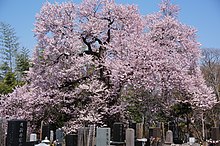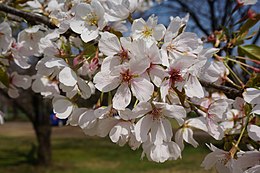
A cherry is the fruit of many plants of the genus Prunus, and is a fleshy drupe.

Prunus is a genus of trees and shrubs in the flowering plant family Rosaceae that includes plums, cherries, peaches, nectarines, apricots, and almonds. The genus has a cosmopolitan distribution, being native to the North American temperate regions, the neotropics of South America, and temperate and tropical regions of Asia and Africa, There are 340 accepted species. Many members of the genus are widely cultivated for their fruit and for decorative purposes. Prunus fruit are drupes, or stone fruits. The fleshy mesocarp surrounding the endocarp is edible while the endocarp itself forms a hard, inedible shell called the pyrena. This shell encloses the seed, which is edible in some species, but poisonous in many others. Besides being eaten off the hand, most Prunus fruit are also commonly used in processing, such as jam production, canning, drying, and the seeds for roasting.

Prunus cerasus is a species of Prunus in the subgenus Cerasus (cherries), native to much of Europe, North Africa and West Asia. It is closely related to the sweet cherry, but has a fruit that is more acidic. Its sour pulp is edible.

The cherry blossom, or sakura, is the flower of trees in Prunus subgenus Cerasus. "Sakura" usually refers to flowers of ornamental cherry trees, such as cultivars of Prunus serrulata, not trees grown for their fruit. Cherry blossoms have been described as having a vanilla-like smell, which is mainly attributed to coumarin.

Hanami is the Japanese traditional custom of enjoying the transient beauty of flowers; flowers in this case almost always refer to those of the cherry or, less frequently, plum trees. From the end of March to early May, cherry trees bloom all over Japan, and around the second week of January on the island of Okinawa. The blossom forecast "cherry blossom front" is announced each year by the Japan Meteorological Agency, and is watched carefully by those planning hanami as the blossoms only last a week or two.

Prunus serrulata or Japanese cherry is a species of cherry tree that grows naturally in Japan, China, Korea, and Vietnam, and it also refers to a cultivar produced from Prunus speciosa, a cherry tree endemic in Japan. Historically, the Japanese have developed many cultivars by selective breeding of cherry trees, which are produced by the complicated crossing of several wild species, and they are used for ornamental purposes all over the world. Of these, the cultivars produced by complex interspecific hybrids based on the Oshima cherry are also known as the Cerasus Sato-zakura Group.

Prunus speciosa, the Oshima cherry, Japanese オオシマザクラ, is native to Izu Ōshima island and the Izu Peninsula on Honshū near Tokyo, Japan.

Prunus itosakura is a wild species of cherry trees native to Japan, and is also the name given to the cultivars derived from this species. Itosakura means thread cherry, and appeared in historical documents from the Heian period in Japan. The scientific name for the hybrid between this species and Prunus incisa is Prunus × subhirtella. Historically, the Japanese have produced many cultivars from this wild species, and they are also called weeping cherry, autumn cherry, or winter-flowering cherry, because of the characteristics of each cultivar.
The Niigata Prefectural Botanical Garden is a 19.8 hectares botanical garden and arboretum located at 186 Kanazu, Akiha-ku, Niigata, Niigata, Japan. It is open daily except Mondays; an admission fee is charged.

Prunus jamasakura, the Japanese mountain cherry, is a species of flowering plant in the family Rosaceae that is endemic to Japan.

Weeping trees are trees characterized by soft, limp twigs. This characterization may lead to a bent crown and pendulous branches that can cascade to the ground. While weepyness occurs in nature, most weeping trees are cultivars. Because of their shape, weeping trees are popular in landscaping; generally they need a lot of space and are solitary so that their effect is more pronounced. There are over a hundred different types of weeping trees. Some trees, such as the cherry, have a variety of weeping cultivars. There are currently around 550 weeping cultivars in 75 different genera, although many have now disappeared from cultivation.

The Miharu Takizakura is an ancient cherry tree in Miharu, Fukushima, in northern Japan. It is a weeping higan cherry and is over 1,000 years old.

The cherry blossom front is the advance of the cherry blossoms across Japan. The Japan Meteorological Agency records the opening and full bloom of the blossoms from Kyūshū in late March to Hokkaidō in the middle of May. The advancing front is also the subject of regular reports by the major news agencies. The cherry blossom is of great public interest in Japan due to its symbolism and the custom of flower viewing known as hanami.

Prunus nipponica, also called Japanese alpine cherry, is a shrub which originates from the islands of Hokkaido and Honshu, Japan. It grows to a height of about 5 meters (16 ft) and can grow in sandy, loamy, and clay soils.

Prunus 'Kanzan' is a flowering cherry cultivar. It was developed in the Edo period in Japan as a result of multiple interspecific hybrids based on the Oshima cherry.

Prunus × nudiflora is a Korean native cherry tree originating from Jeju Island. It is a distinct species from Japanese native Yoshino cherry. King cherry is a rare plant and listed as an endangered species. As of April 2017, 194 king cherry trees were growing around Mt. Halla in Jeju Island. According to Gen-ichi Koidzumi, king cherry is erroneously believed to be discovered by a French missionary Émile Joseph Taquet although what he discovered was a different species.
Yo Takenaka was a Japanese plant geneticist and a Professor of Department of Cell Genetics, National Institute of Genetics. He is notable for researching the phylogenetic classification of cherry blossom. He discovered that Prunus × yedoensis is a crossbreed of two wild species of Japanese cherry; Prunus spachiana forma ascendens and Prunus speciosa by crossing experiments. He was also known as a researcher on Japanese morning glory and Nicotiana.

Prunus subg. Cerasus is a subgenus of Prunus. Species of the subgenus have a single winter bud per axil. The flowers are usually in small corymbs or umbels of several together, but some species have short racemes. The fruit is a drupe and has no obvious groove along the side. The subgenus is native to the temperate regions of the Northern Hemisphere, with two species in North America, four in Europe, two in North Africa, and the remainder in Asia.
In the present day, ornamental cherry blossom trees are distributed and cultivated worldwide. While flowering cherry trees were historically present in Europe, North America, and China, the practice of cultivating ornamental cherry trees was centered in Japan, and many of the cultivars planted worldwide, such as that of Prunus × yedoensis, have been developed from Japanese hybrids.
























